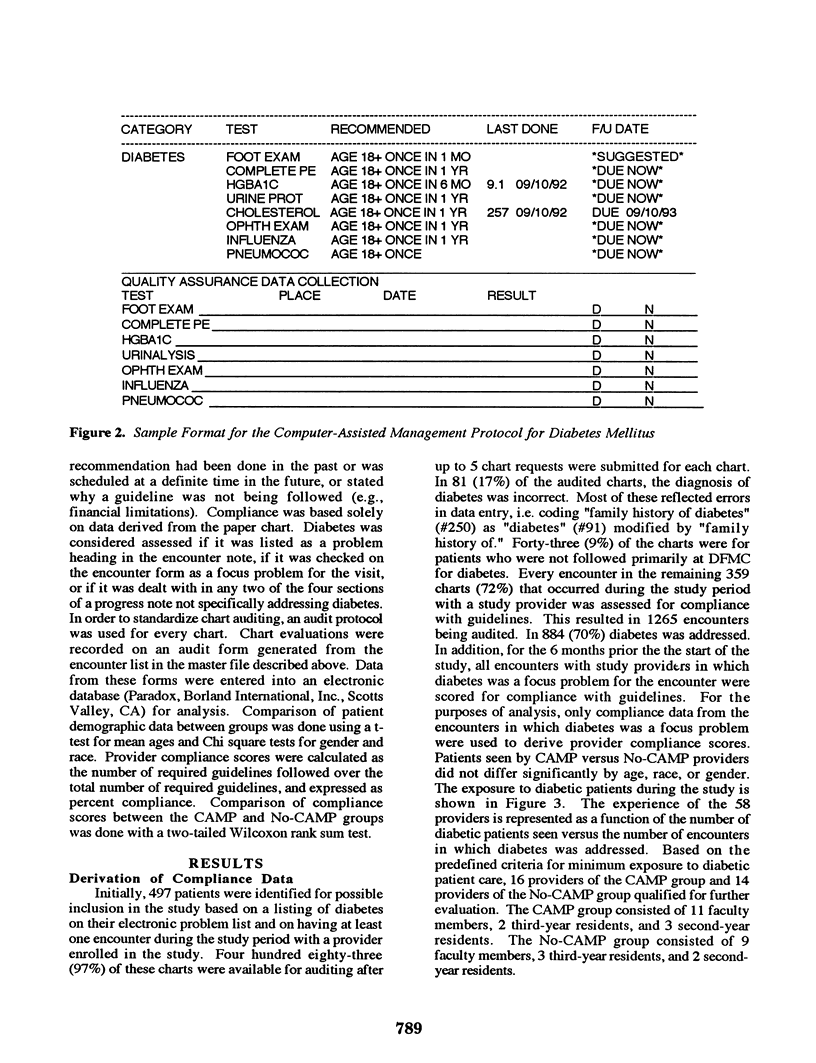Abstract
Disease-specific standards for directing patient management are becoming increasingly important. These standards, however, are often not followed because they are not sufficiently integrated into the clinical care setting. In this study we describe the development and evaluation of a Computer-Assisted Management Protocol (CAMP) of care guidelines for diabetes mellitus. While other studies have shown improved compliance with rule-based reminders, the CAMP customizes disease-specific care guidelines to individual patients over time. We evaluated the effect of the CAMP on compliance with guidelines in a prospective, randomized controlled study. The study was performed at a family practice clinic where much of the patient record is maintained electronically on The Medical Record (TMR). The management protocol was developed from standards published by the American Diabetes Association. Fifty-eight providers were randomized to either receive or not receive the CAMP for diabetes. Compliance with standards was assessed by chart audits of all encounters with diabetic patients during the study interval. The following conclusion was made: the Computer-Assisted Management Protocol resulted in a statistically significant improvement in compliance with diabetes care standards.
Full text
PDF




Selected References
These references are in PubMed. This may not be the complete list of references from this article.
- Ball J. R. Practice guidelines and their role in quality assurance and cost effectiveness. Qual Assur Health Care. 1990;2(1):31–36. doi: 10.1093/intqhc/2.1.31. [DOI] [PubMed] [Google Scholar]
- Barnett G. O., Winickoff R., Dorsey J. L., Morgan M. M., Lurie R. S. Quality assurance through automated monitoring and concurrent feedback using a computer-based medical information system. Med Care. 1978 Nov;16(11):962–970. doi: 10.1097/00005650-197811000-00007. [DOI] [PubMed] [Google Scholar]
- Burns L. R., Denton M., Goldfein S., Warrick L., Morenz B., Sales B. The use of continuous quality improvement methods in the development and dissemination of medical practice guidelines. QRB Qual Rev Bull. 1992 Dec;18(12):434–439. doi: 10.1016/s0097-5990(16)30569-3. [DOI] [PubMed] [Google Scholar]
- Clark C. M., Jr, Kinney E. D. Standards for the care of diabetes. Origins, uses and implications for third-party payment. Diabetes Care. 1992 Mar;15 (Suppl 1):10–14. doi: 10.2337/diacare.15.1.s10. [DOI] [PubMed] [Google Scholar]
- Clark C. M., Jr, Kinney E. D. The potential role of diabetes guidelines in the reduction of medical injury and malpractice claims involving diabetes. Diabetes Care. 1994 Feb;17(2):155–159. doi: 10.2337/diacare.17.2.155. [DOI] [PubMed] [Google Scholar]
- Czaja R., McFall S. L., Warnecke R. B., Ford L., Kaluzny A. D. Preferences of community physicians for cancer screening guidelines. Ann Intern Med. 1994 Apr 1;120(7):602–608. doi: 10.7326/0003-4819-120-7-199404010-00012. [DOI] [PubMed] [Google Scholar]
- McDonald C. J., Hui S. L., Smith D. M., Tierney W. M., Cohen S. J., Weinberger M., McCabe G. P. Reminders to physicians from an introspective computer medical record. A two-year randomized trial. Ann Intern Med. 1984 Jan;100(1):130–138. doi: 10.7326/0003-4819-100-1-130. [DOI] [PubMed] [Google Scholar]
- McDonald C. J. Protocol-based computer reminders, the quality of care and the non-perfectability of man. N Engl J Med. 1976 Dec 9;295(24):1351–1355. doi: 10.1056/NEJM197612092952405. [DOI] [PubMed] [Google Scholar]
- Rosser W. W., McDowell I., Newell C. Use of reminders for preventive procedures in family medicine. CMAJ. 1991 Oct 1;145(7):807–814. [PMC free article] [PubMed] [Google Scholar]
- Stead W. W., Hammond W. E. Computer-based medical records: the centerpiece of TMR. MD Comput. 1988 Sep-Oct;5(5):48–62. [PubMed] [Google Scholar]
- Tape T. G., Campbell J. R. Computerized medical records and preventive health care: success depends on many factors. Am J Med. 1993 Jun;94(6):619–625. doi: 10.1016/0002-9343(93)90214-a. [DOI] [PubMed] [Google Scholar]
- Weingarten S. R., Riedinger M. S., Conner L., Lee T. H., Hoffman I., Johnson B., Ellrodt A. G. Practice guidelines and reminders to reduce duration of hospital stay for patients with chest pain. An interventional trial. Ann Intern Med. 1994 Feb 15;120(4):257–263. doi: 10.7326/0003-4819-120-4-199402150-00001. [DOI] [PubMed] [Google Scholar]


